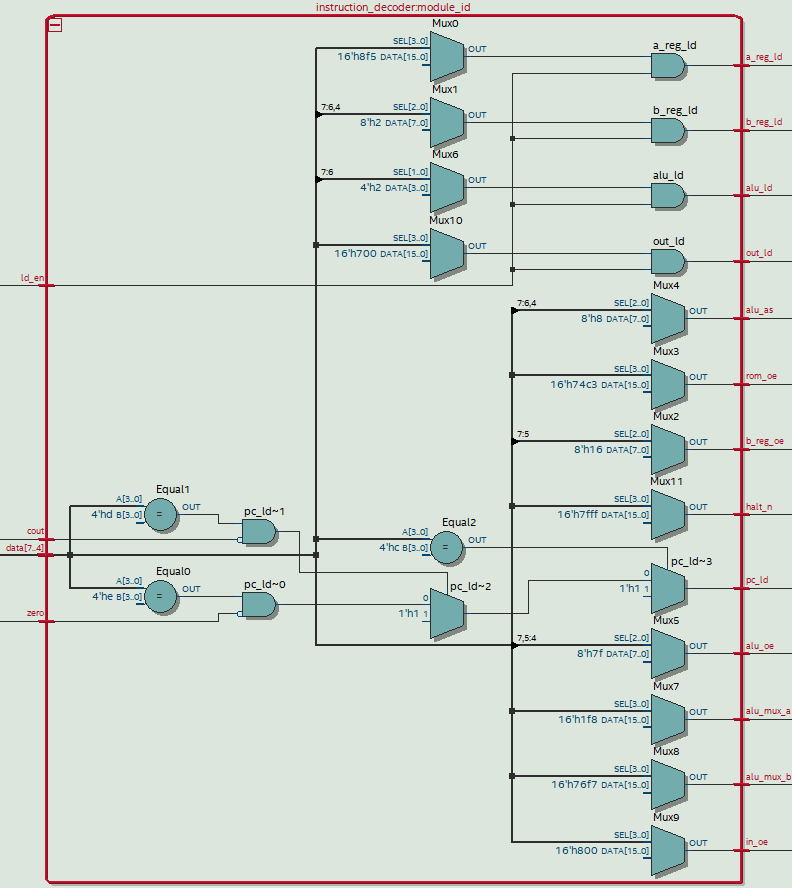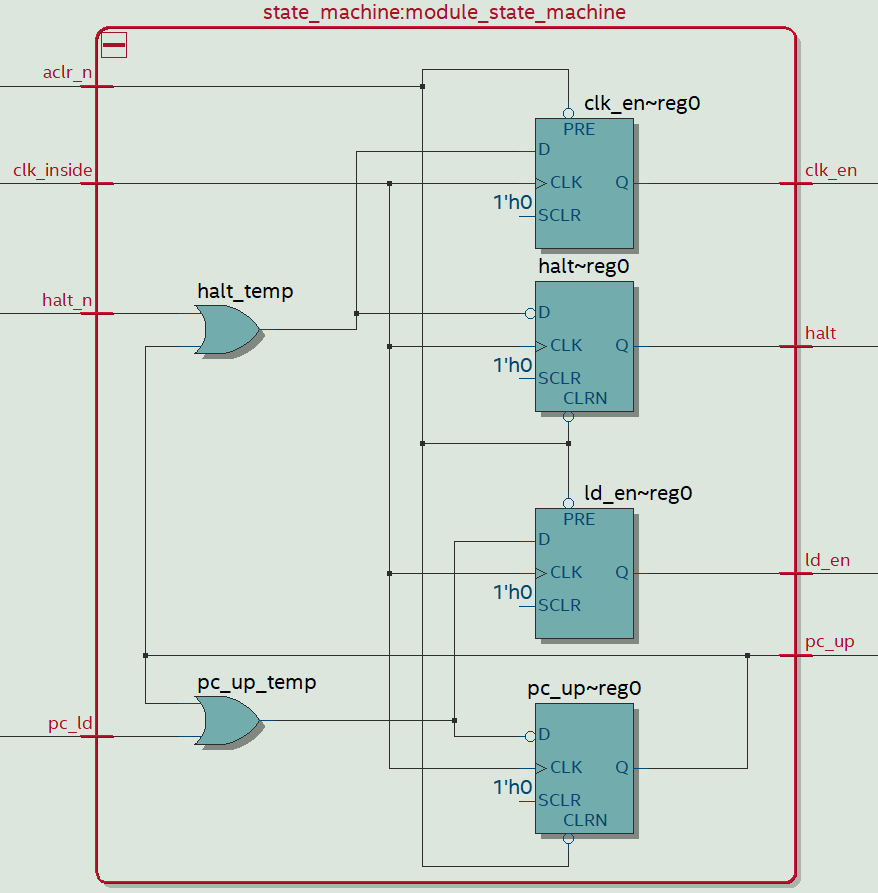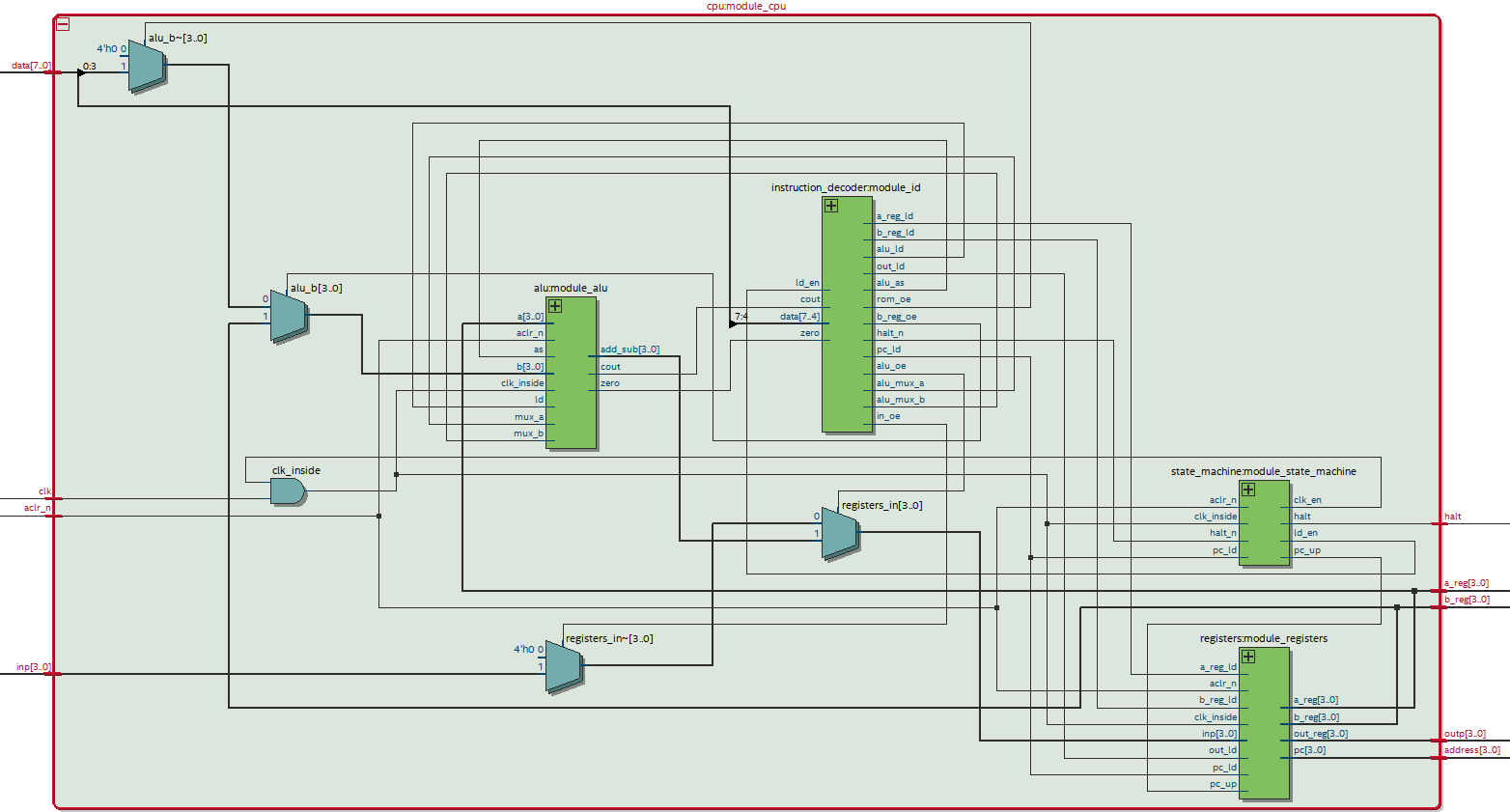1. 概要
テキスト(別府伸耕, 『トランジスタ技術2020年5月号』)はすべて基本ゲートを組み合わせて作り上げているが、とてもそんな真似はできないので、おおむね図34「CPUの全体接続図」(p.126)のモジュールごとにVHDLで記述して組み合わせる。またテキストはバスの選択にトライステートバッファーを使っているが、ここではマルチプレクサに置き換える。
クロックジェネレーターおよびROM (プログラムメモリー)はCPUの創りかたのときと同じく、メモリーブロックとして独立させる。使用したMAX10の評価ボードもCPUの創りかたのときと同じである。
2. モジュールごとに作る
2.1 CPU部を作る
2.1.1 ALUを作る
加減算のほかに、0出力、Aスルー、Bスルー、-Bスルーの各機能がある。
ソースコードを見る/隠す
library ieee;
use ieee.std_logic_1164.all;
use ieee.numeric_std.all;
entity alu is
generic(
NUM_BITS: natural := 4
);
port(
a: in std_logic_vector(NUM_BITS-1 downto 0);
b: in std_logic_vector(NUM_BITS-1 downto 0);
mux_a: in std_logic;
mux_b: in std_logic;
as : in std_logic; -- when 0, add; when 1, sub;
ld : in std_logic;
clk_inside: in std_logic;
aclr_n : in std_logic;
add_sub: out std_logic_vector(NUM_BITS-1 downto 0);
zero : out std_logic;
cout : out std_logic
);
end entity;
architecture rtl of alu is
signal a_temp : unsigned(NUM_BITS-1 downto 0);
signal b_temp : unsigned(NUM_BITS-1 downto 0);
signal calc_temp: unsigned(NUM_BITS downto 0);
begin
a_temp <=
(others => '0') when mux_a = '0' else -- mux_aが0ならオペランドaを強制的に0にし、
unsigned(a);
b_temp <=
(others => '0') when mux_b = '0' else -- mux_bが0ならオペランドbを強制的に0にし、
0-unsigned(b) when as = '1' else -- 引き算のときはオペランドbを2の補数にし、
unsigned(b);
calc_temp <= ('0' & a_temp) + b_temp; -- 1ビット拡張して和(差)を計算して、
process(clk_inside)
begin
if aclr_n = '0' then
-- 非同期クリアして、
add_sub <= (others => '0');
else
-- 和(差)を非同期更新して、
add_sub <= std_logic_vector(calc_temp)(NUM_BITS-1 downto 0);
if rising_edge(clk_inside) then
if ld then
-- キャリーアウトを同期更新して、
cout <= calc_temp(NUM_BITS);
-- ゼロフラグを同期更新する。
if calc_temp(NUM_BITS-1 downto 0) = 0 then
zero <= '1';
else
zero <= '0';
end if;
end if;
end if;
end if;
end process;
end architecture;
2.1.2 A、B、OUTの各レジスタおよびPCを作る
CPUの創りかたのときと同じく、まず共通のカウンター兼レジスタを作っておいて、それを4つまとめて実体化する。
2.1.2.1 共通のカウンター兼レジスタを作る
ソースコードを見る/隠す
library ieee;
use ieee.std_logic_1164.all;
use ieee.numeric_std.all;
entity counter_register is
generic(
NUM_BITS: natural := 4
);
port(
clk : in std_logic;
aclr_n: in std_logic;
sload : in std_logic;
d : in std_logic_vector(NUM_BITS-1 downto 0);
ena_count: in std_logic;
q: out std_logic_vector(NUM_BITS-1 downto 0)
);
end entity;
architecture rtl of counter_register is
signal count: natural range 0 to 2**NUM_BITS-1; -- この信号をカウンターとして使う。
constant COUNT_MAX: natural := 2**NUM_BITS-1; -- カウンターのトップ値。
begin
-- カウント値をそのまま出力する。
q <= std_logic_vector(to_unsigned(count, NUM_BITS));
process(all)
begin
-- !非同期リセット
if aclr_n = '0' then
count <= 0;
elsif rising_edge(clk) then
-- 同期ロード
if sload then
count <= to_integer(unsigned(d));
-- 同期カウント
elsif ena_count then
if count >= COUNT_MAX then
count <= 0;
else
count <= count + 1;
end if;
end if;
end if;
end process;
end architecture;
2.1.2.2 それを4つ実体化して組み合わせる
ソースコードを見る/隠す
library ieee;
use ieee.std_logic_1164.all;
entity registers is
generic(
NUM_BITS: natural := 4
);
port(
inp: in std_logic_vector(NUM_BITS-1 downto 0);
a_reg_ld: in std_logic;
b_reg_ld: in std_logic;
out_ld : in std_logic;
pc_ld : in std_logic;
clk_inside: in std_logic;
aclr_n : in std_logic;
pc_up: in std_logic;
a_reg : out std_logic_vector(NUM_BITS-1 downto 0);
b_reg : out std_logic_vector(NUM_BITS-1 downto 0);
out_reg: out std_logic_vector(NUM_BITS-1 downto 0);
pc : out std_logic_vector(NUM_BITS-1 downto 0)
);
end entity;
architecture rtl of registers is
begin
-- A_REGを実体化
a_register: entity work.counter_register
generic map(
NUM_BITS => NUM_BITS
)
port map(
clk => clk_inside,
aclr_n => aclr_n,
sload => a_reg_ld,
d => inp,
ena_count => '0', -- カウンターを無効化
q => a_reg
);
-- B_REGを実体化
b_register: entity work.counter_register
generic map(
NUM_BITS => NUM_BITS
)
port map(
clk => clk_inside,
aclr_n => aclr_n,
sload => b_reg_ld,
d => inp,
ena_count => '0', -- カウンターを無効化
q => b_reg
);
-- OUT_REGを実体化
out_register: entity work.counter_register
generic map(
NUM_BITS => NUM_BITS
)
port map(
clk => clk_inside,
aclr_n => aclr_n,
sload => out_ld,
d => inp,
ena_count => '0', -- カウンターを無効化
q => out_reg
);
-- PCを実体化
program_counter: entity work.counter_register
generic map(
NUM_BITS => NUM_BITS
)
port map(
clk => clk_inside,
aclr_n => aclr_n,
sload => pc_ld,
d => inp,
ena_count => pc_up, -- カウンターを有効化
q => pc
);
end architecture;
2.1.3 命令デコーダを作る
表10「命令デコーダの真理値表(PC_LD以外)」(p.124)、表11「"PC_LD=1"を出力するときの入力の組み合わせ」(p.124)の各表をそのまま書き写した。
ソースコードを見る/隠す
library ieee;
use ieee.std_logic_1164.all;
entity instruction_decoder is
port(
data: in std_logic_vector(7 downto 4);
zero: in std_logic;
cout: in std_logic;
ld_en: in std_logic;
a_reg_ld : out std_logic;
b_reg_ld : out std_logic;
b_reg_oe : out std_logic;
rom_oe : out std_logic;
alu_as : out std_logic;
alu_oe : out std_logic;
alu_ld : out std_logic;
alu_mux_a: out std_logic;
alu_mux_b: out std_logic;
in_oe : out std_logic;
out_ld : out std_logic;
halt_n : out std_logic;
pc_ld: out std_logic
);
end entity;
architecture rtl of instruction_decoder is
subtype ascending_vect_t is std_logic_vector(0 to 11);
signal truth_tbl: ascending_vect_t;
begin
with data select
truth_tbl <=
ascending_vect_t'("100101001001") when 4d"0", -- LD A, [Data]
ascending_vect_t'("010101001001") when 4d"1", -- LD B, [Data]
ascending_vect_t'("101001001001") when 4d"2", -- LD A, B
ascending_vect_t'("01-001010001") when 4d"3", -- LD B, A
ascending_vect_t'("101001111001") when 4d"4", -- ADD A, B
ascending_vect_t'("101011111001") when 4d"5", -- SUB A, B
ascending_vect_t'("100101111001") when 4d"6", -- ADD A, [Data]
ascending_vect_t'("100111111001") when 4d"7", -- SUB A, [Data]
ascending_vect_t'("00-001010011") when 4d"8", -- OUT A
ascending_vect_t'("001001001011") when 4d"9", -- OUT B
ascending_vect_t'("000101001011") when 4d"10", -- OUT [Data]
ascending_vect_t'("10-00000-101") when 4d"11", -- IN A
ascending_vect_t'("000101001001") when 4d"12", -- JUMP [Address]
ascending_vect_t'("000101001001") when 4d"13", -- JNC [Address]
ascending_vect_t'("000101001001") when 4d"14", -- JNZ [Address]
ascending_vect_t'("000-0-00-000") when 4d"15", -- HALT
ascending_vect_t'(12b"0") when others;
a_reg_ld <= truth_tbl(0) and ld_en;
b_reg_ld <= truth_tbl(1) and ld_en;
b_reg_oe <= truth_tbl(2);
rom_oe <= truth_tbl(3);
alu_as <= truth_tbl(4);
alu_oe <= truth_tbl(5);
alu_ld <= truth_tbl(6) and ld_en;
alu_mux_a <= truth_tbl(7);
alu_mux_b <= truth_tbl(8);
in_oe <= truth_tbl(9);
out_ld <= truth_tbl(10) and ld_en;
halt_n <= truth_tbl(11);
pc_ld <=
'1' when data = 4d"12" else -- JUMP [Address]
'1' when data = 4d"13" and cout = '0' else -- JNC [Address]
'1' when data = 4d"14" and zero = '0' else -- JNZ [Address]
'0';
end architecture;
2.1.4 ステートマシンを作る
図29「ステート・マシンの内部ブロック図」(p.122)の接続図をそのままVHDLで表現した。
ソースコードを見る/隠す
library ieee;
use ieee.std_logic_1164.all;
entity state_machine is
port(
halt_n : in std_logic;
pc_ld : in std_logic;
clk_inside: in std_logic;
aclr_n : in std_logic;
clk_en: out std_logic;
halt : out std_logic;
pc_up : out std_logic;
ld_en : out std_logic
);
end entity;
architecture rtl of state_machine is
signal halt_temp : std_logic;
signal pc_up_temp: std_logic;
begin
process(all)
begin
halt_temp <= halt_n nor pc_up;
pc_up_temp <= pc_ld nor pc_up;
if aclr_n = '0' then
halt <= '0';
clk_en <= '1';
pc_up <= '0';
ld_en <= '1';
elsif rising_edge(clk_inside) then
halt <= halt_temp;
clk_en <= not halt_temp;
pc_up <= pc_up_temp;
ld_en <= not pc_up_temp;
end if;
end process;
end architecture;
2.1.5 CPUにまとめる
ここまで作ったモジュール同士を配線してCPUを作る。
ソースコードを見る/隠す
library ieee;
use ieee.std_logic_1164.all;
entity cpu is
port(
aclr_n : in std_logic;
inp : in std_logic_vector(3 downto 0);
data : in std_logic_vector(7 downto 0);
clk : in std_logic;
halt : out std_logic;
a_reg : out std_logic_vector(3 downto 0);
b_reg : out std_logic_vector(3 downto 0);
address: out std_logic_vector(3 downto 0);
outp : out std_logic_vector(3 downto 0)
);
end entity;
architecture rtl of cpu is
signal alu_b : std_logic_vector(3 downto 0);
signal alu_mux_a : std_logic;
signal alu_mux_b : std_logic;
signal alu_as : std_logic;
signal alu_ld : std_logic;
signal clk_inside: std_logic;
signal add_sub : std_logic_vector(3 downto 0);
signal zero : std_logic;
signal cout : std_logic;
signal ld_en : std_logic;
signal a_reg_ld : std_logic;
signal b_reg_ld : std_logic;
signal b_reg_oe : std_logic;
signal rom_oe : std_logic;
signal alu_oe : std_logic;
signal in_oe : std_logic;
signal out_ld : std_logic;
signal halt_n : std_logic;
signal pc_ld : std_logic;
signal clk_en: std_logic;
signal pc_up : std_logic;
signal registers_in: std_logic_vector(3 downto 0);
signal a_reg_inside: std_logic_vector(3 downto 0);
begin
module_alu: entity work.alu
port map(
a => a_reg_inside,
b => alu_b,
mux_a => alu_mux_a,
mux_b => alu_mux_b,
as => alu_as, -- when 0, add; when 1, sub;
ld => alu_ld,
clk_inside => clk_inside,
aclr_n => aclr_n, -- 外部へ接続
add_sub => add_sub,
zero => zero,
cout => cout
);
module_id:entity work.instruction_decoder
port map(
data => data(7 downto 4), -- 外部へ配線
zero => zero,
cout => cout,
ld_en => ld_en ,
a_reg_ld => a_reg_ld,
b_reg_ld => b_reg_ld,
b_reg_oe => b_reg_oe,
rom_oe => rom_oe,
alu_as => alu_as,
alu_oe => alu_oe,
alu_ld => alu_ld,
alu_mux_a => alu_mux_a,
alu_mux_b => alu_mux_b,
in_oe => in_oe,
out_ld => out_ld,
halt_n => halt_n,
pc_ld => pc_ld
);
module_state_machine:entity work.state_machine
port map(
halt_n => halt_n,
pc_ld => pc_ld,
clk_inside => clk_inside,
aclr_n => aclr_n, -- 外部へ配線
clk_en => clk_en,
halt => halt, -- 外部へ配線
pc_up => pc_up,
ld_en => ld_en
);
module_registers:entity work.registers
port map(
inp => registers_in,
a_reg_ld => a_reg_ld,
b_reg_ld => b_reg_ld,
out_ld => out_ld,
pc_ld => pc_ld,
clk_inside => clk_inside,
aclr_n => aclr_n, -- 外部へ配線
pc_up => pc_up,
a_reg => a_reg_inside,
b_reg => b_reg,
out_reg => outp, -- 外部へ配線
pc => address -- 外部へ配線
);
clk_inside <= clk_en and clk;
-- これがトライステートバッファーから代えたマルチプレクサ
-- ALUの出力かインポートかいずれかをレジスタ群へ渡す。
registers_in <=
add_sub when alu_oe else
inp when in_oe else
(others => '0');
-- これもトライステートバッファーから代えたマルチプレクサ
-- Bレジスタかプログラムメモリーに含まれるオペランドかいずれかをALUへ渡す。
alu_b <=
b_reg when b_reg_oe else
data(3 downto 0) when rom_oe else
(others => '0');
-- A、Bレジスタも確認のため外へ出す。
a_reg <= a_reg_inside;
b_reg <= b_reg;
end architecture;
2.2 クロックジェネレーターを作る
ここで作ったものとまったく同じ。
2.3 ROM (プログラムメモリー)を作る
ここで作ったものとまったく同じ。
2.4 全部組み合わせてCPU1738を完成させる
ソースコードを見る/隠す
library ieee;
use ieee.std_logic_1164.all;
entity cpu1738 is
port(
source_clk : in std_logic;
manual_clk_in: in std_logic;
sel : in std_logic_vector(1 downto 0);
aclr_n : in std_logic;
inp : in std_logic_vector(3 downto 0);
halt : out std_logic;
a_reg : out std_logic_vector(3 downto 0);
b_reg : out std_logic_vector(3 downto 0);
outp : out std_logic_vector(3 downto 0);
clk_out: out std_logic
);
end entity;
architecture rtl of cpu1738 is
signal address : std_logic_vector(3 downto 0);
signal data : std_logic_vector(7 downto 0);
signal clk_inside : std_logic;
signal delayed_clk_0: std_logic;
signal delayed_clk_1: std_logic;
begin
module_cpu: entity work.cpu
port map(
aclr_n => aclr_n, -- 外部へ配線
inp => inp, -- 外部へ配線
data => data,
clk => delayed_clk_1,
halt => halt, -- 外部へ配線
a_reg => a_reg, -- 外部へ配線
b_reg => b_reg, -- 外部へ配線
address => address,
outp => outp -- 外部へ配線
);
module_clk_gen: entity work.clk_gen
port map(
clk => source_clk,
manual_clk_in => manual_clk_in,
sel => sel,
clk_out => clk_inside
);
module_rom: entity work.rom
port map(
clock => clk_inside,
address => address,
q => data
);
-- 確認のためクロックジェネレーターの出力を外へ出す。
clk_out <= clk_inside;
--『CPUの創りかた』のときと同じく、CPUへ与えるクロックを少し遅らせる。
process(clk_out)
begin
if rising_edge(source_clk) then
delayed_clk_0 <= clk_inside;
delayed_clk_1 <= delayed_clk_0;
end if;
end process;
end architecture;
3. ROM (プログラムメモリー)の初期化ファイルを作る
初期化ファイル(.mif)を生成するためのアセンブラのようなものはPythonで作った。
ソースコードを見る/隠す
def generate_mif(file_name, width, depth, rom):
f = open(file_name, "w")
f.write("WIDTH=%d;\n" % width)
f.write("DEPTH=%d;\n" % depth)
f.write("ADDRESS_RADIX=UNS;\n")
f.write("DATA_RADIX=BIN;\n")
f.write("CONTENT BEGIN\n")
format_of_code = "0" + str(width) + "b"
for i in range(depth):
machine_code = format(rom[i], format_of_code)
f.write("%10d : %s;\n" % (i, machine_code))
f.write("END;\n")
f.close()
def LD_A(Data) : return ( 0 << 4)|(Data & 0xF) # A ← [Data]
def LD_B(Data) : return ( 1 << 4)|(Data & 0xF) # B ← [Data]
def LD_AB() : return ( 2 << 4) # A ← B
def LD_BA() : return ( 3 << 4) # B ← A
def ADD_AB() : return ( 4 << 4) # A ← A + B
def SUB_AB() : return ( 5 << 4) # A ← A - B
def ADD_A(Data) : return ( 6 << 4)|(Data & 0xF) # A ← A + [Data]
def SUB_A(Data) : return ( 7 << 4)|(Data & 0xF) # A ← A - [Data]
def OUT_A() : return ( 8 << 4) # OUT ← A
def OUT_B() : return ( 9 << 4) # OUT ← B
def OUT(Data) : return (10 << 4)|(Data & 0xF) # OUT ← [Data]
def IN_A() : return (11 << 4) # A ← IN
def JUMP(Address): return (12 << 4)|(Address & 0xF) # PC ← [Address]
def JNC(Address) : return (13 << 4)|(Address & 0xF) # PC ← [Address] if NOT Carry
def JNZ(Address) : return (14 << 4)|(Address & 0xF) # PC ← [Address] if NOT Zero
def HALT() : return (15 << 4) # HALT
FILE_NAME = "rom_init.mif"
WIDTH = 8
DEPTH = 16
_ = [0] * DEPTH
# テキストのプログラム例(4)
# インポートとアウトポートとを直結しておく。
# 9/2=4(0100)余り1を計算する。
# 0111(9-2=7)、0101(9-2-2=5)、0011(9-2-2-2=3)、0001(9-2-2-2-2=1)の順に表示されたあと、
# 0100(9/2=4)と表示される。
_[0] = LD_A(9) # 割られる数
_[1] = LD_B(0) # 何回引き算ができたかの初期値
_[2] = SUB_A(2) # 割る数(引く数)
_[3] = JNC(10) # 引いた結果が負なら、ループを抜けて10番地へ
_[4] = OUT_A() # 今の引き算結果(すなわち余り)を出力して、
_[5] = LD_AB() # 引き算できた回数をこの3行でインクリメントして、
_[6] = ADD_A(1)
_[7] = LD_BA()
_[8] = IN_A() # 今の引き算結果(すなわち余り)(今OUTレジスタにある)を読み込んで、
_[9] = JUMP(2) # 引き算を繰り返す。
_[10] = IN_A() # (引いた結果が負なら3番地から)余り(今OUTレジスタにある)をAに格納し、
_[11] = OUT_B() # 商(何回引き算ができたか)を出力する。
_[12] = HALT()
generate_mif(FILE_NAME, WIDTH, DEPTH, _)
↓ これが、生成された.mifファイル。
ソースコードを見る/隠す
WIDTH=8;
DEPTH=16;
ADDRESS_RADIX=UNS;
DATA_RADIX=BIN;
CONTENT BEGIN
0 : 00001001;
1 : 00010000;
2 : 01110010;
3 : 11011010;
4 : 10000000;
5 : 00100000;
6 : 01100001;
7 : 00110000;
8 : 10110000;
9 : 11000010;
10 : 10110000;
11 : 10010000;
12 : 11110000;
13 : 00000000;
14 : 00000000;
15 : 00000000;
END;
4. 動かしてみる
9/2=4余り1を計算する。右から4ビットずつ、Bレジスタ、Aレジスタ、一番左がOUTレジスタ。OUTレジスタに7、5、3、1の順に表示されて、最後に商4が表示される。余り1がAレジスタに表示される。
5. ファイル一式
https://github.com/ti-nspire/VHDL_for_Quartus_Prime/tree/main/CPU1738
6. 参考




